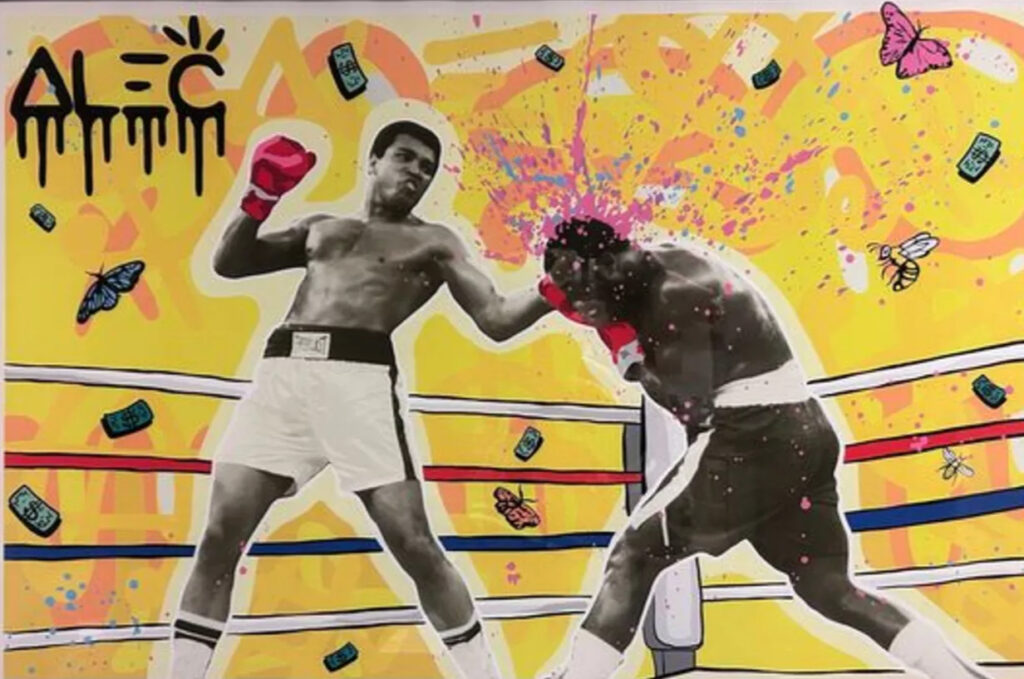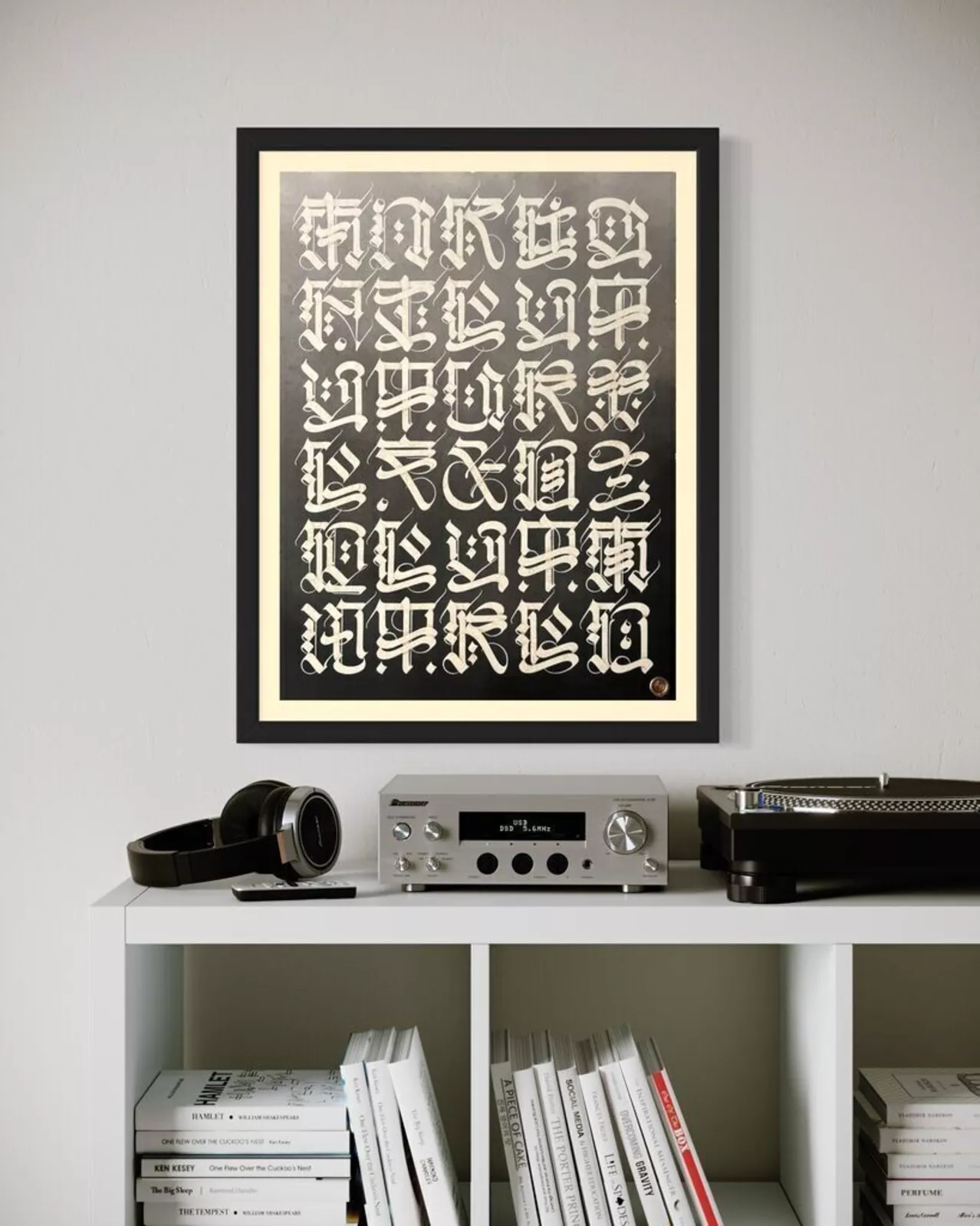Alec Monopoly, an artist whose work has garnered both mainstream attention and underground acclaim, has been known for his satirical and often politically charged pieces. His 2021 work Ali #1 stands as a vivid testament to the artist’s signature style: a fusion of pop culture, social commentary, and striking visual aesthetics. This painting, part of his larger body of work, incorporates recognizable imagery of iconic figures—such as the infamous boxer Muhammad Ali—while embedding layers of symbolism and social critique.
In this analysis, we will dive into the nuances of Ali #1, exploring its thematic elements, visual composition, and the broader implications of the work within both the context of Alec Monopoly’s oeuvre and the wider contemporary art scene. Through this lens, we will uncover how Ali #1 speaks to notions of identity, fame, and the intersection of art and capitalism.
Artist Background:
Alec Monopoly, born in New York City in 1986, began his career as a street artist, drawing inspiration from the urban landscapes of the city. His work often includes images from pop culture, such as the Monopoly board game mascot, popular cartoon characters, and, more recently, famous personalities like Muhammad Ali. Monopoly’s art is instantly recognizable for its bright, bold colors, graphic compositions, and his signature character, often a faceless figure sporting a top hat. Through his work, Monopoly explores the impact of wealth, fame, and power in society.
His street art roots are evident in Ali #1, which continues his long-standing tradition of using pop culture figures to convey social and political messages. By referencing Muhammad Ali—a legendary figure in both sports and activism—Monopoly blends high and low culture, creating a dynamic space for reflection on fame, legacy, and society’s obsession with celebrities.
In Ali #1, Alec Monopoly uses Muhammad Ali’s image not merely as a tribute to the legendary boxer, but as a symbol of something greater. Ali was not only known for his unparalleled skills in the ring but also for his activism, his defiance against the Vietnam War, and his outspoken stance on racial inequality. By incorporating Ali’s likeness into his artwork, Monopoly invokes themes of resistance, power, and social justice. Ali’s image, often depicted with fists raised in victory, communicates strength, resilience, and an unwavering belief in one’s self-worth.
However, Monopoly’s rendering of Ali is far from a traditional or respectful portrait. The bold, cartoonish style strips away the nuanced complexity of Ali’s persona and turns it into a commodity. In doing so, Monopoly critiques how society tends to reduce multi-dimensional figures like Ali into easily digestible images for mass consumption. The artist’s choice to caricature Ali, juxtaposed with vibrant, almost commercialized colors, serves as both a celebration and a critique of how the world adulates and commodifies figures of power.
Monopoly’s work often plays on the intersection of pop culture and capitalism. Ali #1 is no different. The piece draws on the commercial nature of contemporary celebrity culture, where icons like Ali are both revered and monetized. In the contemporary art market, artists who engage with pop culture imagery—whether through the use of celebrities, brands, or media—are often commodifying these symbols in ways that both reflect and critique capitalism’s ability to appropriate any symbol, identity, or cultural figure for profit.
The bright, bold colors in Ali #1 mirror the world of advertising, where products and celebrities are placed on a pedestal for mass consumption. This use of color and abstraction distances the viewer from the complex historical and cultural significance of Muhammad Ali and instead invites them to consider how commercial forces may reduce iconic figures into symbols that are detached from their real-life meaning. In this sense, Monopoly critiques the commodification of celebrity and the exploitation of cultural icons for financial gain.
In many ways, Ali #1 can be seen as a commentary on the politics of representation. Muhammad Ali was, and remains, a potent symbol of resistance against racial and political oppression. By using his likeness, Monopoly taps into this rich legacy of activism. However, the transformation of Ali into a colorful, oversimplified figure also raises questions about how society, and the art world in particular, represent Black figures in ways that are often superficial and commodified.
Ali, through his involvement in civil rights, was an outspoken critic of racial injustice. His decision to refuse to fight in the Vietnam War, his stand against segregation, and his rejection of mainstream expectations made him one of the most iconic and controversial figures of the 20th century. Ali #1 can be viewed as a dialogue about how the art world—and society at large—treats and represents cultural icons, especially Black figures. While his image continues to be used as a symbol of strength, it also raises issues about whether these representations truly honor the multifaceted person that Ali was, or whether they reduce him to a mere icon that fits into a simplified narrative.
Alec Monopoly’s signature style features bright colors and bold lines, which are essential in drawing the viewer’s attention and imparting a sense of vibrancy to the image. In Ali #1, the use of saturated colors—particularly the gold, red, and black palette—imbues the piece with an energetic and even celebratory feel. The exaggerated forms and cartoonish features give the artwork a sense of playfulness, which contrasts with the gravitas of Ali’s legacy.
The use of these stylistic elements can be interpreted in various ways. On one level, the color palette and form could represent the spectacle of celebrity culture—the gaudy, larger-than-life presence of figures like Ali. On another level, the simplicity and abstraction of the figures could be a deliberate choice to focus on the basic visual elements of Ali’s image, rather than the complexity of his life and impact. This tension between the simplified form and the layered complexity of the real-life figure may be an intentional commentary on how culture, media, and art flatten or distort complex individuals into oversimplified symbols.
Ali #1 is not just an aesthetic piece; it also functions as a commentary on broader societal issues, particularly the intersection of race, fame, and representation in contemporary culture. While Muhammad Ali’s story is one of resistance and empowerment, the painting itself questions whether contemporary society continues to respect the true essence of figures like Ali, or whether they are simply used to sell products or promote commercial interests. By taking Ali’s image and transforming it into a colorful, commercialized artwork, Monopoly critiques the way society commodifies resistance, power, and the struggle for justice.
This tension between commodification and political message is a common thread in contemporary art. Many artists use well-known figures, especially those associated with activism or resistance, as a way to explore how these figures are treated in the public sphere. In doing so, Ali #1 forces the viewer to confront the question of whether the true legacy of figures like Muhammad Ali can ever be honored in a way that transcends commodification, or whether all cultural icons are eventually subsumed into the machinery of capitalism.
Alec Monopoly’s work is part of a larger tradition of pop art and street art, both of which often engage with the themes of consumerism, fame, and mass media. Artists like Andy Warhol, who famously turned commercial products and celebrities into art, paved the way for this kind of commentary. Similarly, the graffiti and street art movements, which have their roots in rebellion against mainstream culture, often use celebrity imagery to challenge societal norms.
By placing Ali in the context of this lineage, Monopoly not only pays homage to previous movements but also critiques their limitations. While Warhol and others made art about celebrity culture, Ali #1 adds a layer of critique—posing questions about the ethics of representation and the responsibility of artists in depicting figures like Ali. In this way, the work can be understood as a dialogue with the past and present, offering both a celebration and critique of how we view and consume cultural icons.
Alec Monopoly’s Ali #1 is a striking exploration of the intersection between fame, identity, and capitalism. Through his use of Muhammad Ali’s image, Monopoly critiques the commodification of cultural icons, while also celebrating the enduring power of Ali’s legacy. The artwork raises important questions about how society represents figures like Ali—particularly Black figures—and whether these representations honor the complexity of their lives or reduce them to simplified symbols. In the vibrant, cartoonish world of Ali #1, we see both a tribute to and a critique of the commercialization of resistance and the power of celebrity. As with much of Monopoly’s work, Ali #1 is a bold, thought-provoking piece that speaks to the complexities of identity, fame, and the art world’s relationship with consumer culture.
No comments yet.








